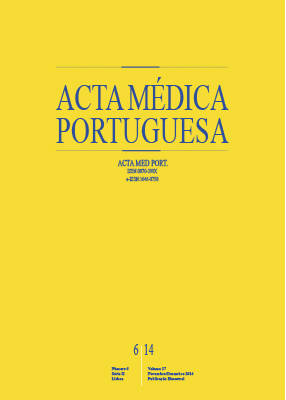Prevalence of Use of Preimplantation Genetic Diagnosis in Unidade Clínica de Paramiloidose from Centro Hospitalar do Porto
DOI:
https://doi.org/10.20344/amp.4972Abstract
Introduction: The Familial Amyloid Polyneuropathy, with the world’s largest focus in Portugal, is recognized by the National Board of Assisted Reproductive Technologies as a serious disease eligible for Preimplantation Genetic Diagnosis. This study aims to determine the prevalence of the use of Preimplantation Genetic Diagnosis in FAP carriers followed in Unidade Clínica de Paramiloidose, Centro Hospitalar do Porto, and to identify the associated factors.Material and Methods: Between January and May 2013, a representative sample of Portuguese Familial Amyloid Polyneuropathy carriers, aged between 18 and 55 years, was systematically recruited. The analysis is based on 111 carriers with previous familial diagnosis, who reported having ever tried to get pregnant after 2001. Data on sociodemographic characteristics and use of Preimplantation Genetic Diagnosis were collected through a self-administered questionnaire. Proportions were compared using the chi-square test. Crude and adjusted odds ratios (OR) and the respective confidence intervals of 95% (95% CI) were estimated using multivariate
logistic regression.
Results: The prevalence of use of Preimplantation Genetic Diagnosis was 20.7% (95% CI: 13.6-29.5). After adjustment, a household income above 1000 €/month (OR = 11.87; 95% CI 2.87-49.15) was directly associated with the use of Preimplantation Genetic Diagnosis, while carriers with an individual diagnosis (OR = 0.15; 95% CI 0.04-0.57) and children born after 2001 (OR = 0.07; 95% CI 0.02-0.32) revealed a prevalence of use significantly lower than those with a individual diagnosis and children born before 2001.
Discussion: The low prevalence of use of Preimplantation Genetic Diagnosis, as well as the less frequent use of the technique by those with a lower household income, shows the importance of improving access to Preimplantation Genetic Diagnosis in the case of Familial Amyloid Polyneuropathy.
Conclusion: This work contributes to increase the sensitivity of health professionals around the use and accessibility to Preimplantation Genetic Diagnosis among Familial Amyloid Polyneuropathy carriers.
Keywords: Preimplantation Diagnosis; Amyloid Neuropathies, Familial; Genetic Testing; Assisted Reproductive Technologies.
Downloads
Downloads
Published
How to Cite
Issue
Section
License
All the articles published in the AMP are open access and comply with the requirements of funding agencies or academic institutions. The AMP is governed by the terms of the Creative Commons ‘Attribution – Non-Commercial Use - (CC-BY-NC)’ license, regarding the use by third parties.
It is the author’s responsibility to obtain approval for the reproduction of figures, tables, etc. from other publications.
Upon acceptance of an article for publication, the authors will be asked to complete the ICMJE “Copyright Liability and Copyright Sharing Statement “(http://www.actamedicaportuguesa.com/info/AMP-NormasPublicacao.pdf) and the “Declaration of Potential Conflicts of Interest” (http:// www.icmje.org/conflicts-of-interest). An e-mail will be sent to the corresponding author to acknowledge receipt of the manuscript.
After publication, the authors are authorised to make their articles available in repositories of their institutions of origin, as long as they always mention where they were published and according to the Creative Commons license.









